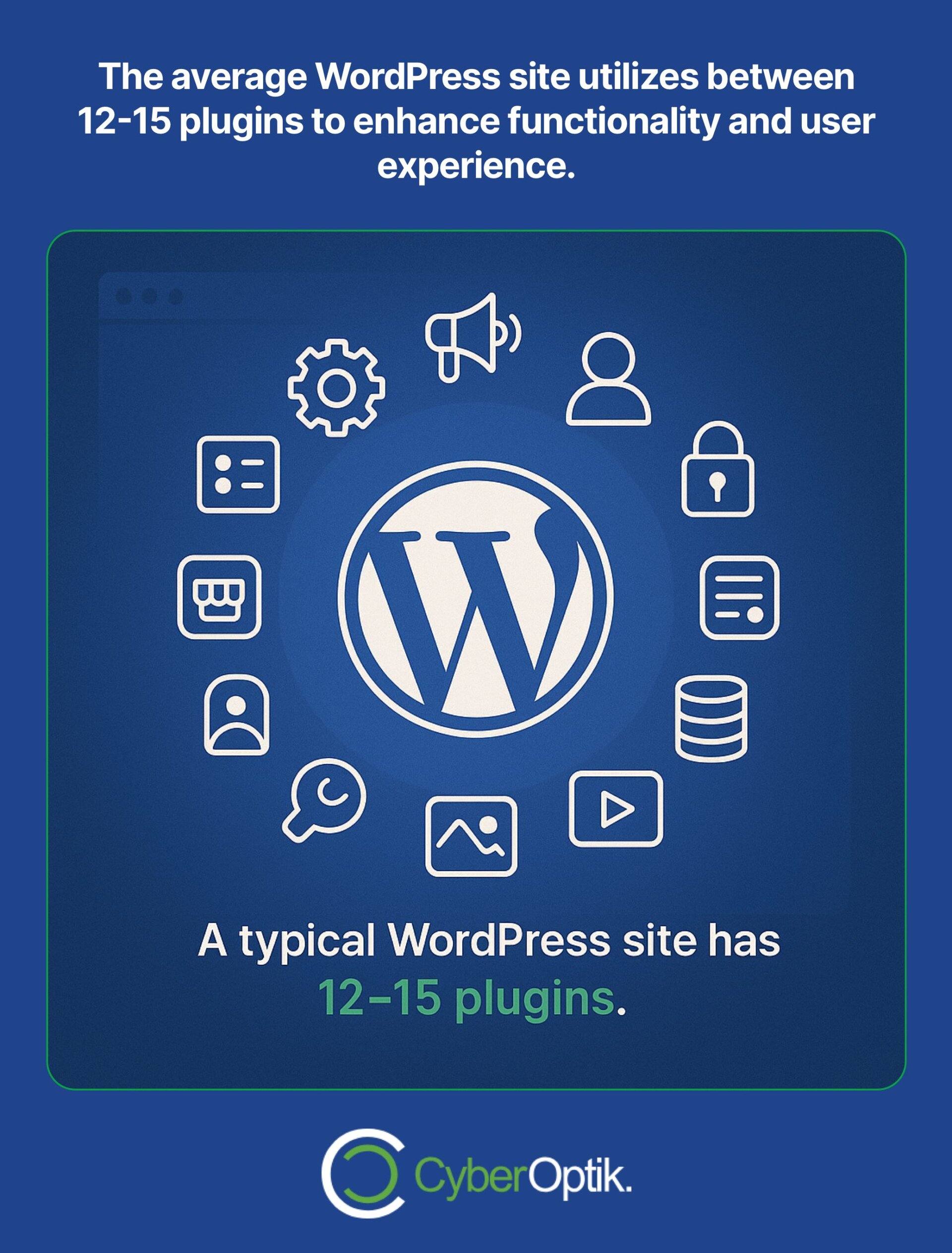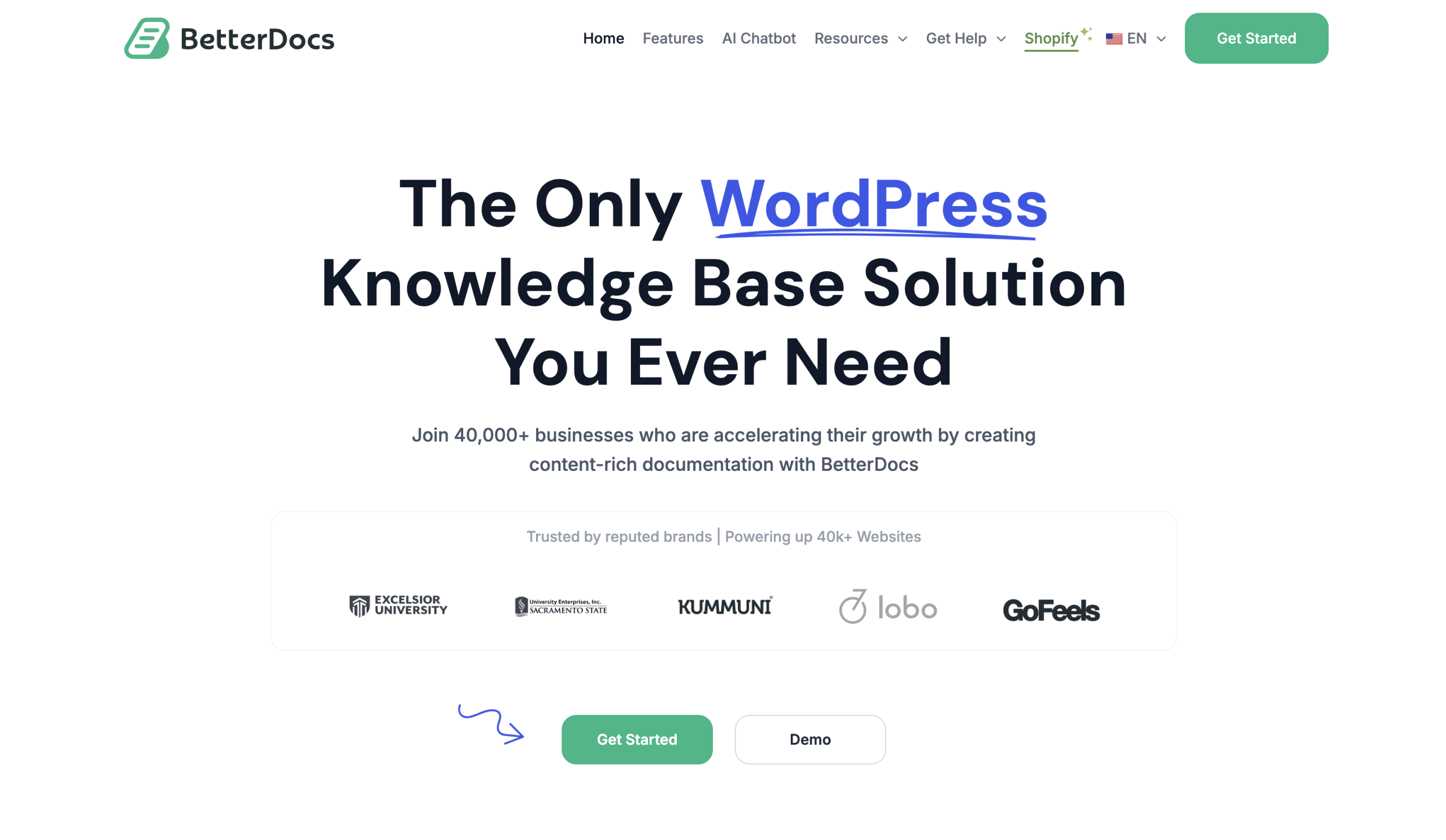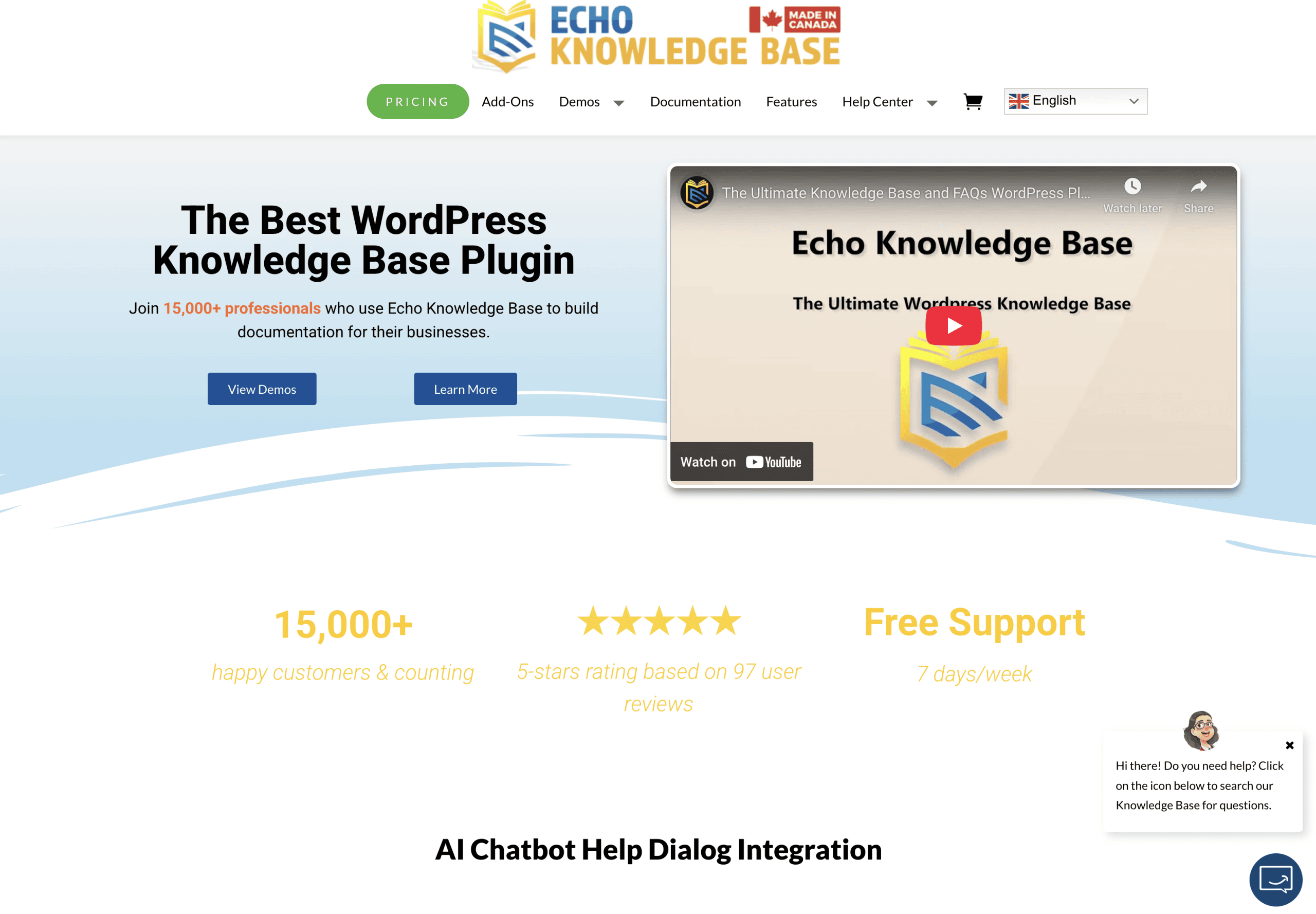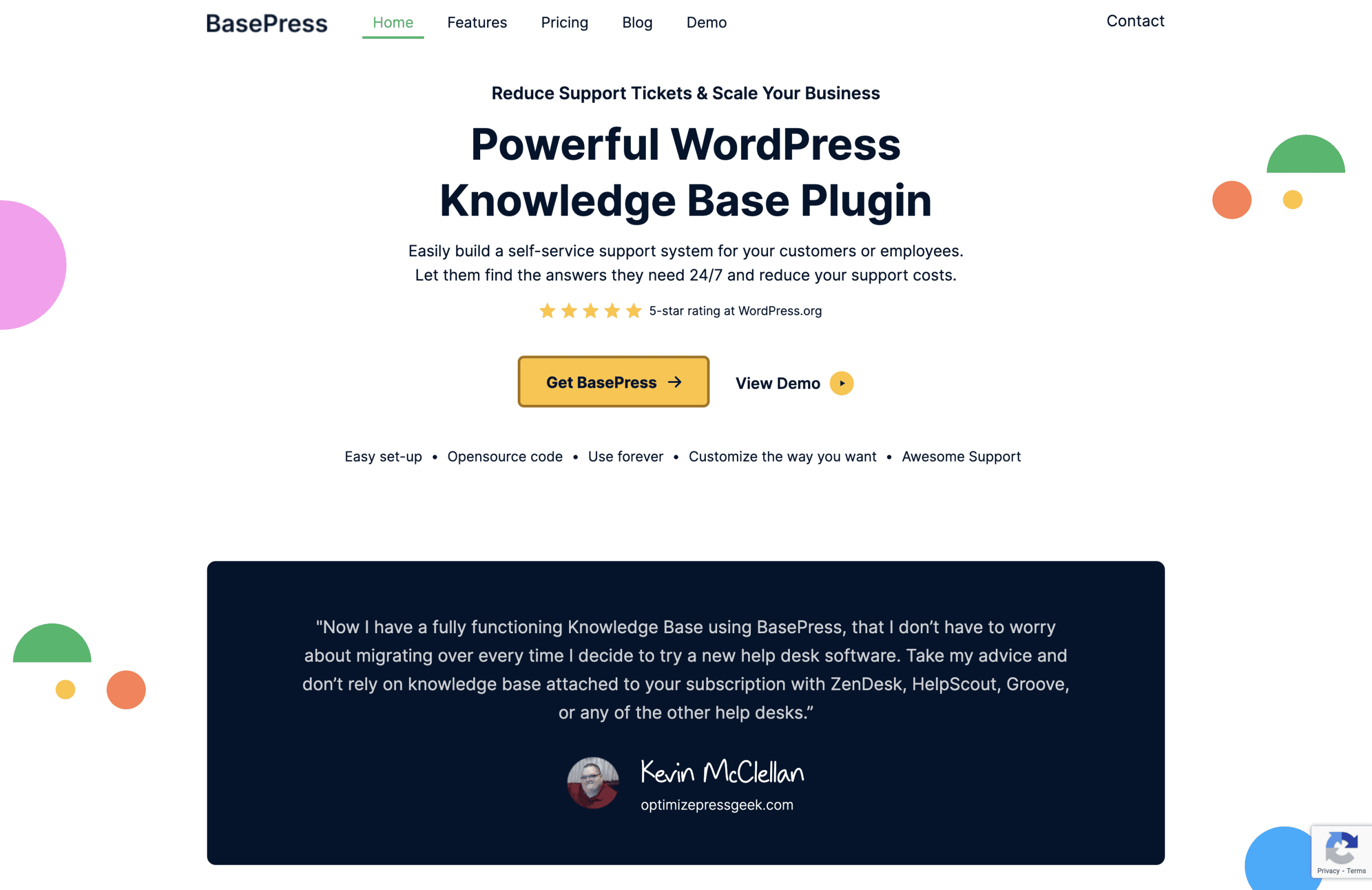Knowledge bases save time. They empower customers to find answers without waiting for support. Our clients consistently report fewer support tickets and higher customer satisfaction after implementing a well-organized knowledge base solution.
Knowledge base plugins transform regular WordPress sites into comprehensive self-service support centers. WordPress powers 43.4% of all websites on the internet, making it the most popular content management system globally. This widespread adoption has created a robust ecosystem of plugins designed to extend WordPress functionality, including specialized tools for creating knowledge bases.
In this guide, we’ll explore the best knowledge base plugins for WordPress to help you make an informed decision. Let’s begin.
Understanding Knowledge Base Plugins and Their Importance
Knowledge base plugins add structure. They transform standard WordPress installations into organized information centers. These specialized tools help businesses create searchable, categorized documentation systems.
Businesses today face increasing pressure to provide instant support solutions. Traditional support methods often struggle to keep pace with customer expectations for immediate assistance. Knowledge bases bridge this gap by offering 24/7 self-service options that empower customers to find solutions independently.

The average WordPress site utilizes between 12-15 plugins to enhance functionality and user experience. With plugins playing such a crucial role in WordPress site performance, selecting the right knowledge base solution becomes a strategic decision.
Let’s examine how traditional support methods compare to knowledge base systems across several key metrics:
| Support Metric | Traditional Support Methods | Knowledge Base Systems |
|---|---|---|
| Availability | Limited to business hours | 24/7 availability |
| Resolution Time | Hours to days (depends on ticket volume) | Immediate (for documented issues) |
| Customer Effort | High (multiple interactions often required) | Low (self-service on their schedule) |
| Scalability | Poor (costs increase linearly with volume) | Excellent (handles unlimited concurrent users) |
| Cost Efficiency | High ongoing costs (staff time) | Low maintenance costs after initial setup |
These comparisons highlight why knowledge bases have become essential components of modern customer support strategies.
The primary benefits of implementing a knowledge base include:
- Reduced support ticket volume – Many common questions get answered without staff intervention
- Lower support costs – Self-service reduces the need for large support teams
- Improved customer satisfaction – Immediate answers lead to better experiences
- Consistent information delivery – All customers receive the same accurate answers
- Support staff efficiency – Teams can focus on complex issues requiring human expertise
A knowledge base complements your broader support strategy. It handles routine questions while freeing your team to tackle complex problems that require human intervention.
Key Features to Look for in Knowledge Base Plugins
Quality varies widely among plugins. Not all knowledge base solutions offer the same capabilities or performance. Understanding the essential features helps you make better decisions when selecting the right tool for your needs.
WordPress’s plugin directory contains over 60,000 free plugins that extend site functionality in countless ways. With so many options available, it’s crucial to evaluate knowledge base plugins based on specific criteria that align with your business requirements.
When evaluating WordPress plugins for knowledge base functionality, consider these essential features:
| Feature Category | Essential Elements | Why It Matters |
|---|---|---|
| Search Functionality | Autocomplete, filtering, search analytics | Helps users quickly find relevant information |
| Content Organization | Categories, tags, hierarchical structure | Creates intuitive navigation and information architecture |
| User Experience | Mobile responsiveness, customizable templates | Ensures consistent experience across all devices |
| Analytics | Search tracking, article performance, user behavior | Identifies content gaps and improvement opportunities |
| Integration | Ticket system compatibility, CRM connections | Creates seamless workflow with existing systems |
| Access Control | Role-based permissions, content restrictions | Protects sensitive information and manages user access |
| SEO Features | Custom URLs, metadata control, schema markup | Improves visibility in search engines |
This feature checklist helps identify which plugins align with your specific requirements. Not every business needs all features, but understanding the options helps you make informed decisions.
Beyond these core features, consider how will your knowledge base contribute to your overall brand awareness strategy? The right plugin should align with your branding while delivering exceptional functionality.
Security considerations also play a vital role in plugin selection. Approximately 60% of WordPress vulnerabilities originate from plugins and themes rather than the core WordPress software. This statistic emphasizes the importance of choosing well-maintained, regularly updated plugins from reputable developers.
Top Knowledge Base Plugins for WordPress
Options abound for knowledge management. After testing dozens of solutions and implementing them for clients across various industries, we’ve identified the standout performers in the WordPress knowledge base plugin category.
Each plugin offers unique strengths that might align better with specific business needs. We’ve evaluated these tools based on feature completeness, ease of use, customization options, and overall value.
Wordfence Security, the most popular WordPress security plugin, has over 5 million active installations, demonstrating the importance of plugin selection in the WordPress ecosystem. Similarly, the top knowledge base plugins have earned their popularity through reliable performance and robust features.
Here’s our comprehensive comparison of the top knowledge base plugins for WordPress:
| Plugin Name | Best For | Pricing Model | Key Strengths | Limitations |
|---|---|---|---|---|
| BetterDocs | Businesses of all sizes needing comprehensive documentation | Freemium ($59-$199/year) | Multiple templates, analytics, instant answers | Advanced features require premium version |
| Echo Knowledge Base | Technical documentation with complex categorization | Freemium ($99-$199/year) | Powerful organization, article ratings, analytics | Higher learning curve for configuration |
| Heroic KB | Integration with support ticket systems | Premium ($129-$249/year) | Seamless ticket integration, content restriction | No free version available |
| BasePress | Multilingual knowledge bases | Freemium ($59-$119/year) | Strong WPML integration, clean design | Limited template options |
| WP HelpDesk | Combined ticket system and knowledge base | Premium ($149-$299/year) | All-in-one support solution, user satisfaction tracking | Potentially more than needed if you only want KB functionality |
This comparison provides a starting point for your evaluation process. Let’s examine each of these plugins in more detail to understand their unique capabilities.
BetterDocs

BetterDocs stands out for flexibility. It combines easy setup with powerful customization options. The plugin offers multiple layout choices and seamless theme integration.
Key features include:
- Instant Answers – Suggests relevant articles as users type questions
- Multiple templates – Several design options without requiring code knowledge
- Analytics dashboard – Tracks article performance and search behavior
- Feedback system – Collects user ratings to identify improvement areas
The plugin works exceptionally well for businesses that need an attractive, user-friendly knowledge base without extensive technical configuration. Its intuitive setup makes it accessible for WordPress beginners while offering enough customization for advanced users.
Echo Knowledge Base

Echo Knowledge Base excels at organization. It offers one of the most robust categorization systems available for WordPress knowledge bases. The plugin particularly suits technical documentation with complex hierarchical relationships.
Standout capabilities include advanced content organization with unlimited categories and articles, powerful search with filters and autocomplete suggestions, built-in analytics to track user engagement, and versatile sidebar configurations for intuitive navigation.
Echo Knowledge Base offers both free and premium versions, with the paid options adding advanced design controls, user feedback systems, and priority support. The main drawback is the steeper learning curve compared to some competitors.
Heroic KB
Heroic KB focuses on integration. It connects seamlessly with help desk systems to create a unified support ecosystem. This plugin works particularly well for businesses already using WordPress-based support ticket systems.
Its primary advantages include direct integration with popular help desk plugins, content restriction capabilities for member-only documentation, extensive customization options without coding requirements, and built-in article ratings and feedback system.
The downside is that Heroic KB only offers premium plans without a free version, making it a larger initial investment. However, businesses needing tight integration between their knowledge base and support system often find the investment worthwhile.
BasePress

BasePress specializes in multilingual support. The plugin offers exceptional WPML compatibility for businesses serving international audiences. It maintains a clean, minimalist interface that adapts well to various business types.
Notable features include excellent multilingual support for global businesses, intuitive content organization with drag-and-drop capabilities, responsive design for all devices, and simplified setup process ideal for non-technical users.
BasePress offers both free and premium versions, with the paid tiers adding more design options and priority support. The main limitation is fewer template options compared to competitors like BetterDocs.
WP HelpDesk

WP HelpDesk provides unified support. It combines knowledge base functionality with a complete ticket system in one integrated package. This all-in-one approach suits businesses looking to consolidate their support infrastructure.
Key capabilities include integrated ticket management system alongside the knowledge base, customer satisfaction tracking through surveys, automated workflow tools for support processes, and comprehensive reporting on support performance.
The primary drawback is that WP HelpDesk might be more than needed if you’re only looking for knowledge base functionality without the ticket system. It also comes with a premium-only pricing model.
Implementing a Knowledge Base on Your WordPress Site
Implementation requires planning. A successful knowledge base depends on thoughtful organization and content strategy. The technical setup is often simpler than the content preparation.
WordPress websites generate approximately 70 million new posts monthly, demonstrating the platform’s content management power. A well-implemented knowledge base leverages this content management capability while adding specialized organization and search features.
Follow these steps to implement your knowledge base effectively:
- Audit existing content – Identify FAQs, support tickets, and documentation that should migrate to your knowledge base
- Plan your information architecture – Create logical categories and subcategories that align with user needs
- Select and install your chosen plugin – Follow our comparison guide to select the best solution for your specific requirements
- Configure settings and appearance – Customize the knowledge base to match your branding and user experience requirements
- Create your initial content – Develop core articles addressing the most common support issues
- Implement user feedback mechanisms – Add rating systems or feedback forms to identify content gaps
- Test thoroughly – Ensure searchability, navigation, and mobile responsiveness work as expected
Planning content structure carefully saves time later. Many organizations start with a small core of essential articles and expand gradually based on user needs and feedback.
For optimal implementation, consider these best practices for organizing your knowledge base content:
| Organizational Element | Best Practice | Implementation Tips |
|---|---|---|
| Categories | Create logical groupings based on user perspective, not internal structure | Limit to 7-10 top-level categories; use subcategories for deeper organization |
| Article Titles | Use question format when possible (How do I...? Why does...?) | Include keywords users actually search for, not internal terminology |
| Content Structure | Start with the answer, then provide details | Use headings, bullet points, and screenshots liberally |
| Related Articles | Link to connected topics to create content pathways | Include 2-3 related article links at the end of each piece |
| Tagging System | Implement consistent tags for cross-category searching | Develop a controlled tag vocabulary to prevent tag sprawl |
This organizational framework creates an intuitive knowledge base that users can navigate easily. The goal is to minimize the cognitive load required to find information.
When creating content for your knowledge base, focus on clarity and precision. WordPress plugins can enhance your content presentation, but the quality of the written material remains the foundation of an effective knowledge base.
Optimizing Your Knowledge Base for SEO
SEO matters for knowledge bases. Well-optimized documentation does double duty as a customer support tool and an organic traffic driver. Proper optimization ensures users find your solutions when searching online.
Sites using visual builders like Elementor (which has over 10 million active installations) see 23% higher conversion rates compared to non-builder sites. Similarly, optimized knowledge bases can significantly improve both SEO performance and user conversion rates.
Knowledge base content provides excellent SEO opportunities because it directly addresses specific user questions – exactly the type of intent-focused content search engines prioritize. Here are key strategies for optimizing your knowledge base:
| SEO Element | Optimization Strategy | Implementation Techniques |
|---|---|---|
| Keyword Research | Identify actual phrases customers use when seeking help | Analyze support tickets, chat logs, and Google Search Console data |
| Article Structure | Create search-friendly content organization | Use question headlines (H1), logical subheadings (H2, H3), and concise paragraphs |
| Schema Markup | Implement FAQ and HowTo schema for enhanced SERP features | Use built-in schema tools or dedicated schema plugins |
| Internal Linking | Create logical content pathways within the knowledge base | Link between related articles with descriptive anchor text |
| Meta Optimization | Craft unique, descriptive titles and descriptions | Include primary keywords and clear value proposition in meta elements |
| Mobile Optimization | Ensure perfect functionality on all devices | Test navigation, search, and readability on mobile devices |
| Page Speed | Optimize loading performance | Compress images, use caching, and minimize plugin conflicts |
Implementing these optimization strategies helps your knowledge base content perform well in search results while providing exceptional user experiences.
Analytics plays a crucial role in ongoing SEO optimization for knowledge bases. Track these key metrics to continuously improve performance:
- Search queries – What terms bring users to your knowledge base articles
- User behavior – Which articles receive the most traffic and engagement
- Content gaps – What questions users search for that lack adequate answers
- Conversion paths – How knowledge base content influences other website conversions
These insights guide continuous improvement efforts for both SEO performance and user experience. Regular content updates based on these metrics keep your knowledge base relevant and effective.
Consider enhancing your WordPress knowledge base with custom design elements that improve both aesthetics and functionality while maintaining strong SEO performance.
Common Challenges and Solutions
Challenges inevitably arise with knowledge bases. Anticipating common problems helps you implement effective solutions before issues impact user experience. Most knowledge base difficulties fall into predictable categories.
The WordPress community generates approximately 77 million new comments on content monthly, showing the platform’s collaborative nature. This collaborative spirit can help address knowledge base challenges through community feedback and continuous improvement.
Here are the most common knowledge base challenges and their solutions:
| Challenge | Impact | Solution |
|---|---|---|
| Content Maintenance | Outdated information causes user frustration and support issues | Implement systematic review cycles; assign content owners; use expiration flagging |
| Difficult Navigation | Users cannot find relevant information despite it existing | Improve categorization; enhance search functionality; add related content suggestions |
| Inadequate Search | Search results don't match user intent or terminology | Implement synonym detection; add keyword tagging; analyze failed searches |
| Low Content Quality | Articles lack clarity, completeness, or accuracy | Develop content standards; implement peer review process; collect user feedback |
| Poor Mobile Experience | Mobile users struggle with navigation and readability | Test thoroughly on multiple devices; optimize image sizing; simplify navigation for small screens |
| Integration Issues | Knowledge base doesn't connect well with other support channels | Select plugins with strong API capabilities; implement cross-linking between systems |
Addressing these challenges proactively leads to more effective knowledge base implementations. Regular monitoring and continuous improvement processes help maintain knowledge base effectiveness over time.
To maximize the effectiveness of your knowledge base, implement these proven solutions:
- Establish content governance protocols – Define who owns content updates and review cycles
- Create content templates – Standardize article formats for consistency and completeness
- Implement user feedback loops – Add ratings, comments, or surveys to identify problem areas
- Use analytics strategically – Monitor search patterns, failed searches, and popular content
- Provide alternative support paths – Offer clear escalation options when self-service isn’t sufficient
These strategies help overcome common knowledge base challenges and create more effective self-service support systems. The key is establishing systematic processes rather than ad-hoc approaches to content management.
Conclusion
Knowledge bases transform support operations. They reduce ticket volume while improving customer satisfaction through immediate self-service options. The right WordPress plugin makes implementation straightforward for businesses of all sizes.
After reviewing the top options, we recommend starting your evaluation with BetterDocs for most general business needs, Echo Knowledge Base for complex technical documentation, and WP HelpDesk for businesses wanting combined knowledge base and ticket system functionality.
Remember that successful knowledge bases require ongoing maintenance and optimization. The initial implementation is just the beginning of a continuous improvement process guided by user feedback and analytics.
A well-implemented knowledge base delivers exceptional ROI through reduced support costs, improved customer satisfaction, and enhanced SEO performance. The investment in proper setup and maintenance pays dividends across multiple business metrics.
Ready to implement a knowledge base on your WordPress site? Contact our team for personalized recommendations based on your specific business requirements. We offer expertise in selecting, implementing, and optimizing knowledge base solutions that align with your broader business goals.




